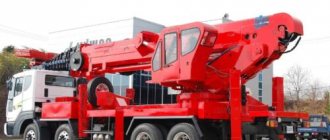Remember the famous thesis expressed by Ostap Bender: “A car is not a luxury, but a means of transportation”? Nowadays it can be supplemented with the words “people and cargo”.
While most motorists have no questions about the rules for transporting passengers, not everyone is familiar with the nuances associated with transporting goods. A whole section is devoted to this issue in the Traffic Rules.
Traffic rules requirements
In the traffic rules, section 23 is devoted to the transportation of goods, consisting of five points, in which the legislator has provided for all possible situations that arise during their transportation by road.
23.1 deals with permissible values for cargo mass. 23.2 requires the driver to control its placement and fastening.
Clause 23.3 of the traffic rules clearly states when the carriage of cargo is allowed and has five paragraphs, of which it is worth mentioning something quite unusual for modern drivers that many drivers forget: the placement of cargo should not interfere with the perception of hand signals.
What is oversized cargo?
Oversized cargo is considered to be cargo with dimensions that do not exceed the norms in force for a vehicle. That is, what is transported is equal to the vehicle itself. Maximum dimensions for the transportation of goods by road are established by traffic regulations and other regulations.
Automotive standards in the European Union
In European countries, the standards regarding the dimensions of transportation by road are determined by Directive 96/53, namely its annex. According to this document, the following restrictions are introduced:
- total length from rear bumper to front: solid-frame truck - 12 m, road train - 18.75;
- body width: isothermal vans - 2.6 m, total - 2.55 m;
- permissible height of cargo for transportation by road transport is up to 4 m;
- weight for vehicles: two-axle - 18 t, three-axle - 24 t, five-, six-axle - 40 t.
In Russia
According to current regulations, road transportation is carried out by vehicles with the parameters given below.
Weight limit
For single vehicles, depending on the number of axles, the following restrictions are accepted:
- two axles - 18 t;
- three axles - 25 t;
- four axles - 32 t;
- five axles - 35 tons.
For semi-trailers, as well as trailed road trains, the following weight requirements have been introduced:
- three axles - 28 t;
- four axles - 36 t;
- five axles - 40 t;
- six axles and more - 44 tons.
Limit dimensions
Restrictions have also been established regarding the permissible dimensions of cargo for transportation by truck:
- distance between the front and rear bumpers: for an automobile train - 12 m, for a single vehicle and trailer - 12 m;
- body width: total - 2.55, isothermal vans - 2.6 m;
- The maximum height of cargo for transportation by road is up to 4 m.
Based on established standards, the maximum parameters of a truck that has the right to move freely on the road are: height - 4 meters, length - 20 meters, weight - 40 tons.
Traffic restrictions
Traffic regulations stipulate that the weight of the transported vehicle should not exceed the parameters set by the manufacturer when developing the vehicle. In addition, other rules regarding the dimensions of road transport apply:
- It is prohibited to transport objects that protrude beyond the vehicle body by more than 1 m at the rear or front, and 0.4 m at the sides;
- what is moved should not block the view of the road, affect the readability of registration plates, headlights, or interfere with the perception of signs that the driver gives by hand;
- the load is securely secured to prevent it from falling, especially when it comes to sheets of plywood, fiberboard, and other similar objects, since they increase aerodynamic resistance;
- if the route is long, then, regardless of the size of the cargo for transportation, vehicles on the road are periodically stopped and the reliability of fastening is checked;
- the loaded vehicle or what it transports must not cause dust, noise or pollute the environment;
- The stability of the vehicle must not be impaired by objects placed on it.
If the maximum dimensions of cargo allowed for transportation by road are exceeded, the driver installs signs notifying that the cargo is large and takes other measures specified in legislative acts to eliminate the likelihood of an emergency on the road.
Permissible dimensions of cargo for transportation by road
What is considered a large-sized cargo, the transportation of which does not require special permits, but has strictly defined transportation rules specified in the traffic rules?
By lenght
If the load protrudes beyond the front and rear dimensions of the vehicle by more than 1 m, but not more than 2 m. It should be noted here that despite the presence of the letter “and”, you can read “or”. Let’s say the load is extended more than a meter just beyond the rear side of the car, but not in front, it is already becoming large.
Width
It also indicates how much the load can protrude across the width of the car - no more than 40cm.
ATTENTION. Unlike the first case, where the length of the protruding part should be measured from the extreme point of the car, here the measurement is made from the edge of the rear marker light, which means that it will actually protrude slightly less than the prescribed 40cm, since the specified lamp is always located somewhat deeper than the extreme side point car.
If, after measurements, at least one parameter exceeds the above standards, it should be o, and in the dark or in case of insufficient visibility, also with flashlights or reflectors: white in front and red in back.
By height
Despite the fact that clause 23.4 of the traffic rules does not talk about the height of the load, it should be remembered that the load should not exceed four meters above the surface of the roadway (clause 23.5 of the traffic rules).
Let's consider this situation: the cargo does not protrude beyond the dimensions of the vehicle, but reaches a height of 3 meters 85 centimeters from the road surface; the “Large cargo” sign is not required.
Sometimes it happens.
Paragraph 23.5 of the traffic rules defines cargo and vehicles for transportation or passage of which will have to obtain a special permit:
Controversial situations
Controversial situations are cases when the inspector takes measurements, but does not have special equipment. Often, traffic police officers take measurements either with a regular stationery ruler or with a tape measure purchased in a store. If a motorist knows that the values voiced based on the results of measurements by traffic police officers are incorrect, it is necessary to ask the inspector for a quality certificate for his measuring device. If the inspector hastened to submit incorrect data on cargo dimensions to the court, the erroneous parameters can always be challenged.
Transportation rules
On the territory of the Russian Federation, the transportation of large cargo is regulated by a number of regulations, in addition to traffic rules, this includes:
The documents are quite voluminous and informative, covering not only the topic under consideration, so we will consider them in the relevant part.
You should start with the loading rules, the basic norms of which are spelled out in sufficient detail. This includes sorting cargo by weight, namely, heavier ones are located at the bottom to maintain vehicle stability when moving; the cargo must be homogeneous and well secured. It is also prescribed to prevent gaps between loaded products, ordering them to be filled with gaskets.
Homogeneous piece cargo in the body of a vehicle must be stacked in compliance with the same number of tiers and ensuring reliable fastening of the top tier of the stack (clause 36 of Order of the Ministry of Transport No. 7 of January 15, 2014).
Here we are talking about the need to attract escort vehicles, justifying this by the increased danger when transporting large-sized cargo (clause 52 of Order of the Ministry of Transport No. 7 of January 15, 2014).
Paragraphs 53-58 of Order of the Ministry of Transport No. 7 of January 15, 2014. establish escort rules and requirements for escort vehicles. Tractors and (or) State Traffic Inspectorate vehicles can be used as these vehicles (clauses 53-58 of Order of the Ministry of Transport No. 7 of January 15, 2014).
Paragraphs 59 and 60 of the same Order of the Ministry of Transport No. 7 dated January 15, 2014 provide an exhaustive list of situations and conditions under which the transportation of such cargo is prohibited:
How is it designated?
Due to the increased danger for road users, these cargoes must be marked with the sign “Large cargo” (clause 23.4 of the Traffic Regulations). This sign is installed directly on the load itself at the extreme protruding point.
Consequently, if the load exceeds the established norms behind the vehicle, it is installed at the rear. If in front and behind - in both places, respectively. The same applies to the designation of protruding parts on the sides of the vehicle.
In addition to the sign, it may be necessary to install white and red lights or reflectors, respectively, at the front and rear, but this requirement is appropriate when transporting at night or in conditions of limited visibility.
“Oversized cargo” sign - dimensions according to GOST
The “oversized cargo” sign, as drivers often call it, simply does not exist in the legal field of the Russian Federation, since it is a colloquial and simplified name for the “Oversized cargo” identification sign.
The dimensions of the sign are determined in the form of a square with a side of 400 mm and alternating inclined stripes of red and white, each 50 mm wide.
The above parameters are provided for by the state standard GOST R12.4.026-2001, and therefore are mandatory.
It is allowed to apply this sign directly to the cargo itself in the form of a sticker or drawing in accordance with the specified GOST.
IMPORTANT. The sign is made of reflective materials!
This sign can be purchased or made independently. The only difficulty that arises is that the sign must be reflective.
There are two ways to solve this problem. The first is to purchase special paint, which is unlikely to be cheaper than buying a ready-made sign. The second is to shell out for a sign sticker and stick it on any solid base, such as a sheet of tin or a PVC panel. The main thing is to keep the dimensions, don’t take risks, don’t make the sign smaller than what is provided for by GOST.
Questions and answers
Question 1:
A fine was received for transporting oversized items, the parameters of which were higher than the permissible values for width and length. What to do?
Answer:
The inspector cannot impose a monetary penalty on the spot from the violator. He submits violation indicators to the court. The guilty person will receive a summons to appear in court. If a citizen knows that there are no violations on his part, he will be able to challenge the indicators.
Question 2:
How long does it take to pay the traffic police receipt that arrived by mail?
Answer:
The fine for transporting oversized cargo must be repaid within 30 calendar days from the moment it arose (previously it was possible to repay the debt within a 60-day period).
Question 3:
I was given a fairly large fine. It turned out that its size was influenced by such an aggravating circumstance as exceeding the speed limit during the transportation of oversized cargo. Can speeding affect the size of the fine?
Answer:
Yes. This is an aggravating circumstance. If oversized cargo is transported on the roadway, the motorist should not exceed a speed of 60 km/h. The permissible speed on bridges is 20 km/h.
Transportation permit
Until now, many motorists who have not encountered the problem of transporting large cargo believe that permission should be obtained from the traffic police. Actually this is not true.
There is a coordination procedure with the State Traffic Inspectorate and it is connected with the duty of this service to determine whether there is a need for cargo escort and in the form of escort (by a carrier with a special car or a traffic police official car).
Permission for transportation is issued by a number of authorized bodies, depending on which roads the route is agreed on: international, federal or municipal. Recently, it has become possible to obtain this permission from the owner of the road, if it is his property.
To begin the procedure for obtaining a special permit, you must submit the appropriate application to the authorized body (see table above), a package of documents is attached to the application: for the car that will be involved in transportation, for the cargo, and the route map. The authorized body also has the right to request additional documentation related to the upcoming transportation.
The time frame for consideration of the application is specified in the administrative regulations and, depending on the number of approvals and related actions (assessment of the condition of the road or the need for strengthening or reconstruction), from five to thirty days.
Obtaining a special permit is a conditionally free procedure. The authorized body has no right to demand a fee for issuing a permit. But the applicant is obliged to pay a state fee in the amount of 1,600 rubles (clause 111 of paragraph 1 of Article 333.33 of the Tax Code of the Russian Federation (part two) dated August 5, 2000 No. 117-F3, as amended by Federal Law dated July 21, 2014 N 221-FZ ).
Additionally, it may be necessary to pay for an assessment of the road for suitability for transporting the cargo in question, as well as work to strengthen or reconstruct sections of the road and engineering structures (for example, bridges) along the planned route. As well as compensation for damage caused by transportation to roads and communications.
Organization of support
Proper transportation of oversized cargo requires the presence of escort. It is only necessary if the width of the oversized cargo is more than 3.5 m, the length is 24 m. Depending on the transportation conditions, the characteristics of the route and the dimensions of the vehicle with the cargo, one of 2 types of escort :
- Cover car . Can accompany a vehicle with cargo only if its width is within 3.5-4 m and length – 24-30 m.
- Traffic police car . Accompaniment by traffic police officers is required for lengths of more than 30 m and widths of more than 4 m.
The escort vehicle must comply with the traffic rules established for such cases. In addition, the cover vehicle must be equipped with certain signs - yellow or orange flashing lights, orange-yellow stripes on the body and “long length”, “large width” badges. The car is also equipped with a special device for measuring the height of structures.
The organization of escort is necessary to ensure safety on the road when transporting large-sized products.
What is the penalty for violation
Responsibility for violation of the rules for the transportation of goods is provided for in two articles of the Code of Administrative Offenses of the Russian Federation.
Article 12.21 - Violation of the rules for the carriage of goods. Sanction: warning or fine in the amount of 500 rubles.
This article applies to cargo that does not require special permission and liability may arise in an approximate number of cases: the absence of a “Large cargo” sign, the cargo is noisy, dusty or not securely fastened, making it difficult to see.
IMPORTANT. There is no sanction for deprivation of the right to drive a vehicle, but according to Article 23.3 of the Traffic Regulations, further movement until the identified violations are eliminated is prohibited, and registration of a violation does not give the right to continue the trip.
Article 12.21.1 of the Code of Administrative Offenses of the Russian Federation provides for liability for violating the rules of movement of a large vehicle. And here we are talking specifically about cargo that requires special permission. In total, the article has 11 parts:
As you can see, the types of punishments are quite harsh, and parts 3.5 and 6 of Art. 12.21.1 provide for the deprivation of the right to drive a vehicle for various periods.
IMPORTANT. For violations provided for in Part. 1-6 Article 12.21.1, the provision of Article 27.13 of the Code of Administrative Offenses prescribes the detention of the vehicle and its placement in a specialized parking lot until the identified violations are eliminated.
How will the traffic police prove your guilt?
Traffic police representatives can easily prove the guilt of a violator who transported cargo that exceeded the permissible parameters.
The traffic police measure oversized objects with a classic telescopic ruler. If they go beyond acceptable parameters, the violator will be punished and he will be forced to pay money for the violation.
Important!
When the traffic police representative takes measurements, you should carefully monitor his every step, since there are cases when the inspector himself adds 2-3 centimeters in length to the oversized vehicle.
To prevent such situations from arising, before transporting the cargo, it is necessary to independently carry out a control measurement.
A small nuance
Please note that for special rules for the transportation of goods, paragraph 23.5 of the traffic rules sets the norm at two meters from the rear point
car. How far can he protrude from the front? Not a word, therefore, according to the principle “everything that is not prohibited is permitted,” there are no specific restrictions.
It turns out that if the other conditions for length, width and height are not violated, if the load does not limit the view, does not deprive the car of stability and controllability, the sign “Large cargo” is installed and special permits are not required in this case.
Payment of collections at a discount
If it was not possible to avoid the penalty, you can reduce the fine by half. It is enough to make payment within 3 days after drawing up the protocol. The new rules apply to all types of violations, including improper transportation of oversized items.
Oversized transportation and fines for overloading – an expert’s answer:
To avoid having to pay a fine, follow the rules and regulations established by law. Be sure to mark the cargo and obtain permission for its transportation. If you had to incur an administrative penalty, then the penalty should be paid immediately in order to reduce its size by half.









